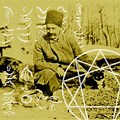Church turns on MSNBC host Al Sharpton over $500,000 in payments from Harris campaign
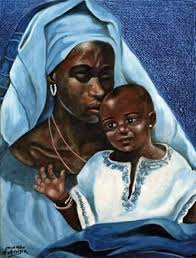









Church turns on MSNBC host Al Sharpton over $500,000 in payments from Harris campaign
A black church group has called on MSNBC to suspend one of its lead anchors over reports he received $500,000 in undisclosed donations from Kamala Harris’ campaign.
Host Al Sharpton interviewed Ms Harris twice in October on his show PoliticsNation in the lead up to election day.
FEC filings later revealed her campaign had made two donations of $250,000 each to the presenter’s non-profit National Action Network, with the network admitting last week that it was “unaware” of the payments.
The National Black Church Initiative, which represents 150,000 black churches across the country, has said that the payment to Mr Sharpton’s group “puts a moral stain on the integrity of the black Church”.
As well as being a television host, Mr Sharpton is a baptist minister and civil rights activist.
The group, which claims to represent 27.7 million churchgoers across the country, said it was “very concerned” by the “growing scandal” and urged MSNBC to “launch an investigation”. It also called for “Rev Sharpton’s suspension until the investigation is complete”.
‘Significant ethics concerns’
The Rev Anthony Evans, the church group’s president, told The Washington Free Beacon that Mr Sharpton was “loved and admired by many in our coalition”, but added: “That does [not] take away from the fact he is facing significant moral and journalism ethics [concerns] regarding this payment or donation to the National Action Network.”
“In addition, Rev Sharpton is a minister of the Gospel. This payment does not look good for a man supposed to represent integrity,” he said.
Mr Sharpton is a vocal Democrat supporter who spoke at the party’s national convention in August, but one of the presenter’s MSNBC colleagues told Fox News that the six-figure transaction his group received from the Harris campaign is a “bridge too far”.
Mr Sharpton with Kamala Harris at a church service in 2023. He is a long-time supporter of the Democrats - Andrew Nelles-Pool/Getty Images
The $250,000 donations to National Action Network, which Mr Sharpton founded in 1991, were made on Sept 5 and Oct 1, shortly before MSNBC aired the presenter’s interviews with Ms Harris on Oct 3 and Oct 20.
Mr Sharpton has a history of financial troubles, having pleaded guilty in 1993 to not filing his 1986 tax return in exchange for having two felony charges dropped.
In 2008, reports claimed the television host owed nearly $1.5 million in back taxes. Meanwhile, the New York Times reported in 2014 that records showed more than $4.5 million in current state and federal tax liens against him and his for-profit businesses.
Mr Sharpton told the outlet the outstanding balance was much lower than records showed.
It comes as MSNBC has been hit by a double header of scandals over payments and political bias, after it emerged that Rachel Maddow, one of its lead presenters, had renewed her contract for $25 million a year.
The network’s future remains uncertain after its parent company, Comcast, recently revealed plans to spin off the channel.
Elon Musk, who labelled the network “utter scum on earth” after it spliced together footage of a Nazi rally and a Trump campaign event, floated the possibility of buying it.
“How much does it cost?” he asked, in response to a post about the network’s potential sale.
MSNBC was approached for comment.
Story by
Bishop T.D. Jakes Reveals He Had “Emergency Surgery” After Mid-Sermon Health Scare










Bishop T.D. Jakes Reveals He Had “Emergency Surgery” After Mid-Sermon Health Scare

Bishop T.D. Jakes shares an update on his health after experiencing a medical emergency last week. In a clip shared on social media, the 67-year-old spoke to members of his church via livestream on Sunday (Dec. 1) detailing the weight of the shocking moment.
“I’m so delighted to see you. I’m grateful for God’s faithfulness. I’m grateful for your faithfulness. I’m grateful for this season in my life,” began the Potter’s House Of Dallas church senior pastor. “I told you last Sunday that I’d see you this Sunday, and so here I am.”
Bishop Jakes continued to explain, “I am grateful to God for his goodness and his mercy and grace. Many of you don’t realize that you’re looking at a miracle. I faced a life-threatening calamity. I was rushed to the ICU unit. I had emergency surgery.”
In the end, he relayed that he’s “taking a few weeks to just heal and recover and relax and just reflect,” as medical professionals want him to go slow when returning to his everyday activities.
Bishop Jakes was rushed to receive medical care last week after an emergency health scare, causing him to pause speaking, shake, and drop the microphone while preaching during a church service. In his initial comeback message, the West Virginia native detailed, “It was quiet and it was peaceful, and I was cradled.”
“Bishop Jakes is stable and under the care of medical professionals. The entire Potter’s House family is grateful for the outpouring of love, prayers, and support from the community,” revealed a statement from the religious institution at the time.
Popes Who Sold Their Souls
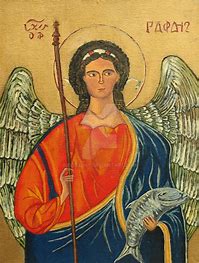









Popes Who Sold Their Souls
Pope Sylvester II (born c. 945- died 5-12-1003)
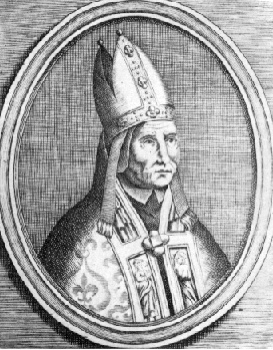
Pope Sylvester II was one of the most learned men of his time. Well versed in mathematics, astronomy, and mechanics; he is credited with inventing the hydraulic organ, pendulum clock, and introducing Arabic numerals to Western Europe. He also wrote books on mathematics, natural science, music, theology and philosophy. Pope Sylvester II was the first French Pope and certainly the most significant in the 10th century. Upon his death, rumors began to fly that his great intelligence – and, consequently his inventive genius – was the result of a pact with the devil. This was most likely due to his regular contact with great scientific minds in the Arab world and his brave attempts to root out simony in the Church.
Father Urbain Grandier -(born c. 1590- died 8-16-1634)
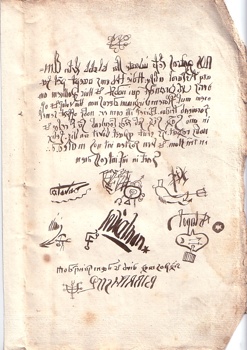
Father Urbain Granadier was a French Catholic priest who was burned at the stake after being convicted of witchcraft. He served as priest in the church of Sainte Croix in Loudun, in the Roman Catholic Diocese of Poitiers. Ignoring his vow of priestly celibacy, he is known to have had sexual relationships with a number of women and to have acquired a reputation as a philanderer. In 1632, a group of nuns from the local Ursuline convent accused him of having bewitched them, sending the demon Asmodai, among others, to commit evil and impudent acts with them. At his trial, the judges, after torturing the priest, introduced documents purportedly signed by Grandier and several demons as evidence that he had made a diabolical pact. They were written backwards in Latin and even included the signature of Satan himself. The text of the pact read as follows (the original can be seen above – click for a larger view):
St. Theophilus of Adana-(died c. 538)
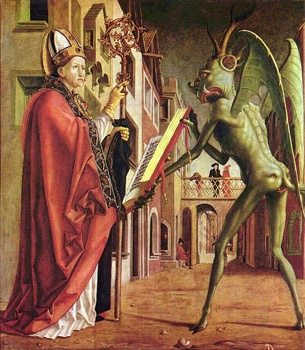
Saint Theophilus the Penitent, or Theophilus of Adana (died ca. 538), was a cleric in the sixth century Church who is said to have made a deal with the devil to gain an ecclesiastical position. His story is significant as it is the oldest story of a pact with the Devil. Theophilus was the archdeacon of Adana, Cilicia, which is part of modern Turkey. He was unanimously elected to be a bishop, but turned the position down out of humility. Another man was elected in his stead. When the new bishop unjustly deprived Theophilus of his position as archdeacon, Theophilus regretted his humility and sought out a wizard to help him contact Satan. In exchange for his aid, Satan demanded that Theophilus renounce Christ and the Virgin Mary in a contract signed with his own blood. Theophilus complied, and the devil gave him the position as bishop.
Years later, fearful for his soul, Theophilus repented and prayed to the Virgin for forgiveness. After forty days of fasting, the Virgin appeared to him and verbally chastised him. Theophilus begged forgiveness and Mary promised to intercede with God. He then fasted a further thirty days, at which time Mary appeared to him again, and granted him Absolution. However, Satan was unwilling to relinquish his hold over Theophilus, and it was a further three days before Theophilus awoke to find the damning contract on his chest. He then took the contract to the legitimate bishop and confessed all that he had done. The bishop burned the document, and Theophilus expired, out of sheer joy to be free from the burden of his contract.
Reference: ListVerse.com
Justin Welby: The archbishop who battled depression due to ‘messy’ early life
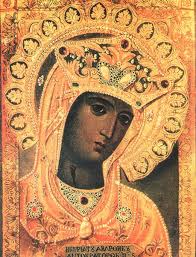








Justin Welby: The archbishop who battled depression due to ‘messy’ early life
In his role as Archbishop of Canterbury, Justin Welby has presided over royal weddings and funerals – but he has also spoken of a “messy” early life and subsequent battle with depression.
Before being ordained in 1992, Mr Welby had an 11-year career in the oil industry.
He was installed as Archbishop of Canterbury in a service at Canterbury Cathedral in March 2013.
He also strongly criticised the previous Conservative government’s scheme to send asylum seekers who cross the Channel in small boats to Rwanda, which he warned was “leading the nation down a damaging path”.
A short time later he gave a speech hinting at his own experiences of being trolled online, speaking of the downsides of social media and hitting out at society’s “absolutely appalling” attitude to forgiveness in an apparent reference to cancel culture.
On that occasion, he said: “All of us know – I know especially at the moment, I’m not going to go into that one, I’m not going to go into debates in Parliament – but we know at the moment what it is to be trolled, to be threatened.”
Faith has acted as a “safety net” for the church leader, who has spoken of his personal experiences with depression which had led him to experience feelings of “self-hatred, self-contempt, real, vicious sense of dislike of oneself”.
As well as being a church leader in England, he is a spiritual leader to around 85 million people across the globe in what is known as the Anglican Communion.
He sits in the House of Lords and has been outspoken on political issues including child poverty – condemning the “cruel” two-child benefit policy – and assisted dying, the legalisation of which he has warned could lead to a “slippery slope”.
He also strongly criticised the previous Conservative government’s scheme to send asylum seekers who cross the Channel in small boats to Rwanda, which he warned was “leading the nation down a damaging path”.
A short time later he gave a speech hinting at his own experiences of being trolled online, speaking of the downsides of social media and hitting out at society’s “absolutely appalling” attitude to forgiveness in an apparent reference to cancel culture.
On that occasion, he said: “All of us know – I know especially at the moment, I’m not going to go into that one, I’m not going to go into debates in Parliament – but we know at the moment what it is to be trolled, to be threatened.”
Faith has acted as a “safety net” for the church leader, who has spoken of his personal experiences with depression which had led him to experience feelings of “self-hatred, self-contempt, real, vicious sense of dislike of oneself”.
In April 2023, in a series of lectures at Canterbury Cathedral to mark Holy Week, the archbishop said taking antidepressants had helped him to “react like an average sort of human being”.
Using a Winnie the Pooh analogy, he said antidepressants “restore me to Eeyore status from something much worse”.
In 2016, Mr Welby revealed that his biological father was the late Sir Anthony Montague Browne – Sir Winston Churchill’s last private secretary.
This had come as “a complete surprise” through DNA evidence, he said at the time, having believed his father was Gavin Welby, the man who raised him.
His mother, Lady Williams of Elvel, described the revelation as “an almost unbelievable shock”, but added she recalls going to bed with Sir Anthony “fuelled by a large amount of alcohol on both sides”.
In a statement at the time Mr Welby said: “I know that I find who I am in Jesus Christ, not in genetics, and my identity in him never changes.”
Gavin Welby died “as a result of the alcohol and smoking” in 1977, when the archbishop was 21, while Lady Williams died aged 93 in July 2023.
Lady Williams of Elvel (Fiona Hanson/PA) (PA Archive)
She had also battled alcoholism and Mr Welby has previously said that “as a result of my parents’ addictions my early life was messy”.
In October 2024, he revealed one of his ancestors owned slaves at a plantation in Jamaica.
He said a recent trip to the country “has helped me to confront the legacies of enslavement in the Caribbean”.
Mr Welby has also spoken lovingly of his own family, paying tribute to his “exceptionally precious” daughter Ellie, who is neurodiverse.
In his role as church leader, Mr Welby has been front and centre on major state occasions, not least the coronation of the King in 2023.
He anointed and crowned Charles, and admitted beforehand the thought was giving him “nightmares”, saying: “I dreamt we got to the point (of the coronation) and I’d left the crown at Lambeth Palace.”
He had, in September the previous year, officiated the late Queen Elizabeth II’s funeral service, telling mourners at Westminster Abbey the monarch had touched “a multitude of lives” and was a “joyful” figure for many.
Mr Welby also officiated the wedding of the Duke and Duchess of Sussex in 2018 and has christened some of the royal children over the years.
Within the church, the archbishop has had to deal with division over the issue of same-sex blessings.
Following a vote in 2023 in favour of the move, an organisation representing some Anglican churches questioned his fitness to lead.
The Global South Fellowship of Anglican Churches (GSFA) criticised the passing of the motion, while others have consistently argued the church has not gone far enough and should allow same-sex marriage.
Mr Welby spoke a number of times during a lengthy Synod debate on the matter, and recognised there is “very painful” disagreement on the issue within the church.
His latest challenge has seen him face calls to resign in the wake of a report into a barrister thought to have been the most prolific serial abuser to be associated with the Church of England.
Critics say the findings of the Makin review, which concluded Mr Welby should have alerted authorities in the UK and Africa in 2013 to abuse committed by John Smyth, mean his position as archbishop has become untenable.
Mr Welby said the review had made clear that he “personally failed to ensure that after disclosure in 2013 the awful tragedy was energetically investigated”.
But he said while he had given resignation “a lot of thought”, he had taken advice from senior colleagues and has decided he will stay in post.
Story by Aine Fox: The Independent:
Articles-Latest
- Koran burning conviction sparks fury as blasphemy law 'returns to UK'
- Robert Francis Prevost - Pope Leo XIV
- Pope Francis' death follows recent health challenges. Here's what we know about how he died.
- Easter April 2025 - international Celebrations
- The Rule of the twelve psalms -Worthy is the Lamb
- Religion in Africa Before Christianity and Islam
- 6 The Origin of Yahweh
- Dumo Di Milano
- What Did the Crow Tribe Believe In: Discover The Beliefs!
- 7 Reasons Historic Christianity Rejects the Book of Enoch
- 8 Breathtaking Mountain Monasteries Around the World
- Ethiopian Bible is oldest and most complete on earth
- Muhammad Muhammad was a prophet and founder of Islam.
- World Day of the Poor – SVP Christmas Campaign 2024
- Pope Francis to open 5 sacred portals on Christmas Eve — for a ritual that’s never been done before
- The 144,000 in Revelation
- Over 73 dead bodies 'used for meditation', 600 crocs in a pond, found in two Thai temples
- Occultism: Western Occult Tradition
- What is a Mudra
- Blood Sacrifices: Ancient Rituals of Life and Death
Articles-Most Read
- Home
- Let There Be Light
- Plants that feel and Speak
- The Singing Forest
- The Singing Forest-2
- Introduction
- Meditation
- Using Essential Oils for Spiritual Connection
- Heaven Scent
- Plants that Feel and Speak-2
- Purification
- Making the Spiritual Connection
- Anointing
- Essential Oils: The unseen Energies
- The Sanctity of Plants
- The Aroma Of Worship - Introduction
- The Aroma Of Worship-Foreward
- Methods Of Use
- Spiritual Blending
- Handling and Storage




